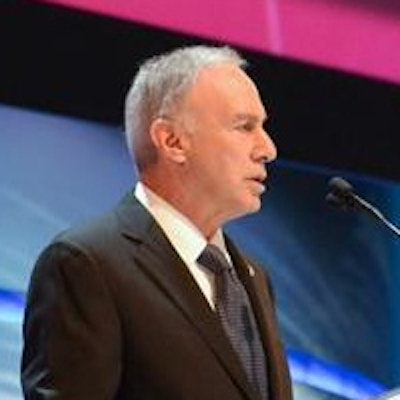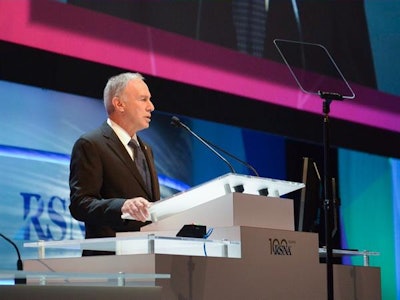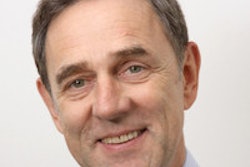
CHICAGO - Technology and collaboration are radiology's new frontiers, and the specialty would do well to adopt Captain James Kirk's famous 1960s-era statement of the Star Trek Enterprise's mission -- "to boldly go where no man has gone before," RSNA President Dr. Ronald Arenson told attendees at the opening session of the society's 101st annual meeting.
"We have a few things to learn from Captain Kirk about being bold explorers and pursuing radiology's version of 'new civilizations,' " he said. "We're in the midst of tremendous change and complexity in healthcare, but the need for imaging services is only going to increase as the population ages."
Part of this new exploration must include a shift from an expert-centered culture to a team-centered one, said Dr. Darrell Kirch, president and CEO of the Association of American Medical Colleges (AAMC), in a special lecture that followed Arenson's address. And academic radiology can lead the way.
"As we work to integrate the entire continuum of care, the goal for radiology will be to figure out at what points imaging is used and to make it effective and efficient," Kirch said.
Going boldly
What does "going boldly" mean for radiology? It means persevering as the delivery of healthcare becomes increasingly complex, and as factors such as the aging of the global population pressure physicians to do more with less, Arenson said.
"There's never been a more exciting era for radiology, with the new and growing demand for personalized, evidence-based medicine and integrated healthcare delivery," he said. "But there are also higher expectations from government and payors to curb spending, as well as a tidal wave of chronic disease that comes with an aging population."
 RSNA President Dr. Ronald Arenson addresses attendees at this year's opening session.
RSNA President Dr. Ronald Arenson addresses attendees at this year's opening session.Technology is radiology's area of expertise, and the field has made key contributions over the past decades, not the least of which is the development of PACS and RIS. Radiology's future will involve further use of metabolic and molecular imaging; using high-intensity focused ultrasound to treat a variety of diseases; developing steerable catheters under MR guidance; and even wearable devices and hyperfast, quantum computers that will process images in the blink of an eye, Arenson said.
"Today's innovators are critical to our field, and they will move us in new directions," he said. "In a few years, the technology we'll be using will make what we have now pale in comparison."
A perfect storm
Radiology's technological innovation will play out amidst a complex amalgam of factors, from a coming physician shortage and increasing numbers of insured patients to healthcare payment reform and tighter research funding, Kirch said in a lecture titled "Radiology, Medicine, and Healthcare: Will Inaction or Innovation Determine Our Future?"
"There's a great transformation going on in healthcare around the world, and we need to take steps to prepare for this change," he said.
Academic centers can lead the effort, according to Kirch -- in part because they provide 23% of all clinical care and 37% of charity care, despite comprising only 5% of U.S. hospitals. These centers and their associated teaching hospitals have developed special expertise, and they have been able to generate positive margins for patient care and then reinvest in innovation, according to Kirch.
"Academic centers are indispensable, and as such can't afford complacency," he said. "Although we're in a tough situation, academic medical centers are in a critical position to lead our health systems to a better place."
So how can academic radiology offer leadership in healthcare reform? Kirch offered seven suggestions:
- Reorganize the culture: Shift from the old model of hierarchical, individualistic, and competitive healthcare delivery to a new model that is collaborative, team-based, mutually accountable, and patient-centered. "To quote Peter Drucker: 'Culture eats strategy for lunch every day,' " Kirch said. "We need to change the culture of medicine before our new strategies will be successful."
- Embrace a model of leadership that will support this new culture: "We need to move from a 'Moses' model of leadership to something more collaborative," he said. "As [author] Liz Wiseman says, a good leader is a 'multiplier' -- that is, someone who can draw out each team member's strengths."
- Harness the power of teams: What tends to pass for a team is usually a committee -- a collection of people who represent their group's position rather than actually working together toward something new, according to Kirch. It takes time to develop an effective team, but it's worth it, he said.
- Develop new care models: Integrating healthcare doesn't necessarily mean consolidating hospitals, Kirch said. It also means redesigning payment models to be less about "rescue" care and more about preventative care. "The Choosing Wisely initiative is a good example of this," he said. "It asks the question, 'What does the evidence tell us about how best to use imaging, and when?' "
- Realign resources to support innovation: Physicians need to analyze their mission and their financial performance, and cut activities that don't support both, according to Kirch. "For example, if we want patient-centered care, using [relative value units (RVUs)] may not be the best way to measure our work," he said.
- Rebuild resilience in the face of change: "Foster a shared sense of purpose and mutual support," Kirch said.
- Recommit to core ethical obligations: Patient care is not about politics -- it's a matter of ethics, according to Kirch. "We need to remember our core principles: autonomy, justice, beneficence, and nonmaleficence," he said.
Developing and integrating new technology must be done in the context of this new culture of the practice of medicine, he concluded.
"Somehow we need to figure out how to maintain that ethical connection to our patients, even if there's an iPad in the physician's lap and there are 20 specialists involved," he said. "That's our task as we move forward."



















